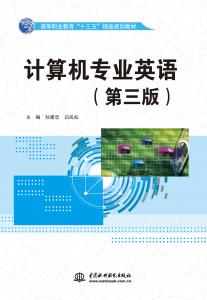计算机专业英语(第三版)

-
【作 者】孙建忠 白凤仙
【I S B N 】978-7-5170-4660-8
【责任编辑】杨庆川
【适用读者群】本专通用
【出版时间】2016-12-09
【开 本】16开
【装帧信息】平装(光膜)
【版 次】第1版第1次印刷
【页 数】232
【千字数】361
【印 张】14.5
【定 价】¥28
【丛 书】高等职业教育“十三五”精品规划教材
【备注信息】
简介
本书特色
前言
章节列表
精彩阅读
下载资源
相关图书
本书以计算机和网络技术为背景,对计算机英语进行了全面的描述。全书涉及计算机的历史与发展、计算机的组成结构、数据结构、操作系统、软件工程、计算机语言、因特网、万维网、网络与安全、物联网、云计算、数据库管理系统、多媒体和动画等14个主题,并介绍计算机技术与应用的一些最新发展。
本书所选材料语言规范、内容新颖、完整实用。每一章均包括:学习指导与小结、课文、注释与译文、阅读材料、练习与专业英语专题等内容。专业英语专题包括计算机词汇及其构成规律、科技英语的阅读与翻译技巧、科技论文及其摘要的写作、商业书信以及日常求职英语等必备知识。
本书可作为高职高专计算机专业的专业英语教材,也可作为使用计算机的广大科技工作者的参考书。
本书配有电子教案,读者可以从中国水利水电出版社网站和万水书苑免费下载,网址为:http://www.waterpub.com.cn/softdown/和http://www.wsbookshow.com。
本书以计算机和网络技术为背景,对计算机英语进行了全面的描述专业英语专题包括计算机词汇及其构成规律、科技英语的阅读与翻译技巧、科技论文及其摘要的写作、商业书信以及日常求职英语等必备知识
每一章均包括学习指导与小结、课文、注释与译文、阅读材料、练习与专业英语专题等内容,语言精练,内容实用,穿插案例,图文并茂,易学易懂易用
免费提供电子教案等教学资源
今天,人类已经进入了“互联网+”时代,物联网,云计算,大数据,人类正在迎来又一次信息产业浪潮。地球村的出现打破了传统的时空观念,使人们与外界乃至整个世界的联系更为紧密。由于诸多原因,国际上最通用的语言还是英语;而因特网的普及,更巩固了英语作为跨文化交往通用语言的地位。因此,为了掌握最新的信息技术,了解信息技术的发展动向,必须具备较高的英语水平。本书的编写目的,首先是让学生掌握计算机专业英语的基本术语,了解一些计算机专业的基本知识;其次是为了介绍信息技术的一些最新发展。
本书以计算机与网络技术为背景,充分考虑了计算机英语的复杂性和新颖性,针对高职高专的教学特点,精心组织,合理选材。主要内容包括:计算机的历史与发展、计算机的组成结构、数据结构、操作系统、软件工程、计算机语言、因特网、万维网、网络与安全、数据库管理系统、多媒体、动画、物联网和云计算等的基本概念等共14章。
本书为第3版,第1、2版受到了广大读者的关心和支持,热心的读者还专为第1版课文提供了部分译文,借本书第3版出版的机会对广大读者的支持再次表示衷心的感谢。
根据教材的使用情况及计算机技术的发展,对本书进行了修订。在延续第1、2版编写风格的基础上,对教材内容进行了更新,删去了一些过时的内容,增加了反映计算机技术和信息技术发展水平的新内容;全书按照计算机基础、计算机网络与计算机应用三个部分进行了组织;考虑到学生的实际需要,系统而扼要地介绍了计算机词汇构成规律、科技英语的阅读与翻译技巧、科技论文及其摘要的写作以及求职英语和广告英语的特点;为了便于教学,还附有参考译文。
本书由大连理工大学孙建忠、白凤仙主编,主要编写人员具体分工为:第1、2、3、13、14章由孙建忠编写,第4、5、6、7章由程立编写,第8、9、10、11、12章由白凤仙和姚卫红编写。参加本书编写的还有李若芬、周龙、秦世宏、李智、李梅、刘翌南、李琳等。
由于作者水平有限,编写时间仓促,本书在编写过程中难免出现疏漏,恳请读者不吝赐教,邮件地址:sjzbfx@163.com。
编 者
2016年8月
学习指导 1
1.1 The Invention of the Computer 1
1.1.1 The ENIAC 1
1.1.2 The UNIVAC I 2
1.2 Computer Generations 2
1.2.1 First-Generation Computers: 1951~1958 3
1.2.2 Second-Generation Computers: 1959~1963 3
1.2.3 Third-Generation Computers: 1964~1970 4
1.2.4 Fourth-Generation Computers:1971~? 4
1.2.5 Generationless Computers 5
Reading Material: Classes of Computing Applications and Their Characteristics 6
科技英语的特点 7
Exercises 10
Chapter 2 Basic Organization of Computers 11
学习指导 11
2.1 Introduction 11
2.2 System Buses 12
2.3 Instruction Cycle 13
2.4 CPU ORGANIZATION 15
Reading Material: Eight Great Ideas in Computer Architecture 17
计算机英语专业词汇的构成 19
Exercises 23
Chapter 3 Binary System and Boolean
Algebra 24
学习指导 24
3.1 The Decimal System 24
3.2 The Binary System 26
3.3 Boolean Algebra 26
数学公式的读法(Pronunciation of mathematical expressions) 28
Exercises 31
Chapter 4 Elementary Data Structures 32
学习指导 32
4.1 Stacks and queues 32
4.1.1 Stacks 32
4.1.2 Queues 33
4.2 Linked lists 35
4.2.1 Searching a linked list 36
4.2.2 Inserting into a linked list 36
4.2.3 Deleting from a linked list 36
4.2.4 Sentinels 37
Reading Material: Related Concepts 38
常用英汉互译技巧 40
Exercises 45
Chapter 5 Operating System 46
学习指导 46
5.1 OS Functions 46
5.1.1 Resource allocation and related
functions 46
5.1.2 User interface related functions 48
5.2 FreeBSD vs. Linux vs. Windows 2000 49
Reading Material: RATs 52
被动语态的译法 54
Exercises 57
Chapter 6 Software Engineering 58
学习指导 58
6.1 Basic Software Concepts 58
6.1.1 Application Software 59
6.1.2 System Software 59
6.2 The Software Life Cycle 60
6.2.1 System engineering and analysis 61
6.2.2 Software requirements analysis 61
6.2.3 Design 61
6.2.4 Coding 61
6.2.5 Testing 61
6.2.6 Maintenance 62
6.3 Prototyping 63
Reading Material: Software Engineering Methodologies 64
长定语(从句)的翻译技巧之一 66
Exercises 69
Chapter 7 Programming Language 70
本章学习指导 70
7.1 Introduction to Programming Language 70
7.2 Object-oriented Programming 72
7.3 OMG's Unified Modeling Language(UML) 73
Reading Material: Programming Paradigms 75
长定语(从句)的翻译技巧之二 78
Exercises 81
Chapter 8 The Internet 82
学习指导 82
8.1 The Internet: Key Technology Concepts 82
8.2 Other Internet Protocols and Utility
Programs 88
8.3 Internet Service Providers 89
Reading Material: Transition from IPv4 to IPv6 91
英语长句的翻译 92
Exercises 96
Chapter 9 The World Wide Web 97
学习指导 97
9.1 Hypertext 97
9.2 Markup Languages 98
9.3 Web Servers and Clients 100
9.4 Web Browsers 101
Reading Material: Features of The Internet and
The Web 102
学术论文的英文写作简介 107
Exercises 109
Chapter 10 Network Security 110
学习指导 110
10.1 Secure Networks and Policies 110
10.2 Aspects of Security 111
10.3 Responsibility and Control 111
10.4 Integrity Mechanism 111
10.5 Access Control and Passwords 112
10.6 Encryption and Privacy 112
10.7 Public Encryption 113
10.8 Authentication with Digital Signatures 114
10.9 Packet Filtering 115
10.10 Internet Firewall Concept 116
Reading Material: KINDS OF SECURITY BREACHES 117
科技论文标题的写法 118
Exercises 120
Chapter 11 Database System 121
学习指导 121
11.1 Overview 121
11.2 Database Models 123
11.2.1 Flat File 123
11.2.2 Relational 123
11.2.3 Hierarchical 124
11.2.4 Other Database Models 125
11.3 Data Mining 126
英文论文引言的写作技巧 127
Exercises 134
Chapter 12 Multimedia and Compuer
Animations 135
学习指导 135
12.1 Multimedia 135
12.1.1 Visual Elements 136
12.1.2 Sound Elements 136
12.1.3 Organizational Elements 137
12.1.4 Multimedia Applications 137
12.2 Computer Animation 138
12.2.1 Design of Animation Sequences 138
12.2.2 General Computer-Animation
Functions 139
英文摘要的写作技巧 140
Exercises 144
Chapter 13 Anatomy of the Internet of Things 145
学习指导 145
13.1 Traditional Internet Protocols Aren’t the Solution for Much of the IoT 146
13.1.1 Introducing the “Chirp” 146
13.1.2 Functionality the IoT Needs—and Doesn’t 147
13.1.3 Efficiency Out of Redundancy 148
13.2 It’s All Relative 150
13.2.1 Format Flexibility 151
13.2.2 Private Markers for Customization and Extensibility 151
13.2.3 Addressing and “Rhythms” 152
13.2.4 Family Types 152
13.3 Applying Network Intelligence at Propagator Nodes 153
13.3.1 Transport and Functional Architectures 154
13.3.2 Functional Network Topology 156
13.3.3 Defined by Integrator Functions 156
13.3.4 Harvesting Information from the IoT 157
13.3.5 Programming and “Bias” 157
13.3.6 Receiver-Oriented Selectivity 158
求职英语简介 159
Exercises 162
Chapter 14 Cloud Computing 163
学习指导 163
14.1 Definitions 163
14.2 Related Technologies for Cloud
Computing 165
14.3 Cloud Service Models 168
14.4 Cloud Deployment Models 169
14.5 Public Cloud Platforms: State-of-the-Art 170
14.6 Business Benefits of Cloud Computing 172
广告文体简介 173
Exercises 176
参考译文 177
参考文献 226
- 信息技术基础(麒麟操作系统+WPS Office) [主编 芮雪 蒋莉 王亮亮]
- Office高级应用项目式教程(第2版) [主编 李观金 张倩文 黎夏克 ]
- 巧用翻译学英语:英汉互译500例 [王学文 著]
- 高等教育多维评价体系构建与高质量发展研究 [张妍 著]
- 系统规划与管理师章节习题与考点特训(第二版) [主编 薛大龙]
- 计算机操作系统实践指导(openEuler版) [主编 秦光 曾陈萍 岳付强]
- 信息系统管理工程师真题及模考卷精析(适用机考) [主 编 薛大龙 程 刚 上官绪]
- 航海类院校体育教育教学研究 [张利超 李宁 著]
- 新时代背景下我国职业教育产教融合长效机制建设研究 [王玉贤 著]
- 电路分析 [主编 李飞 毛先柏]
- 信息系统管理工程师(适用第2版大纲)一站通关 [指尖疯 编著]
- 传统山水画论解读与实践 [陈钠 著]
- 网络工程师备考一本通(适配第6版考纲) [夏杰 编著]
- 陈孝云的职教理想与情怀 [祝吉太 江传瑞 张义廷 著]
- 地方本科院校电子信息学科课程思政案例集 [王甫]
- Excel数据处理与分析(第二版) [主编 张志明 邹 蕾]
- 网络工程师5天修炼(适配第6版考纲) [主编 朱小平 施游]
- 仓储管理实务(第二版) [周宁武 编著]
- 基于AE与C#的地理信息系统二次开发 [李小根 贾艳昌 乔翠平 姜彤 ]
- 2023年长沙市文化和旅游业发展报告 [主编 陈莉]
- 舞台化妆造型设计 [主编 刘思彤 张 涛 张忆雨]
- 产教融合视角高校体育专业实践教学体系构建研究 [杨柳青 叶华兵 著]
- 知识图谱及应用案例 [张善文 黄文准 于长青 陈明淑]
- Python程序设计案例教程(微课版) [主编 石利平 田辉平 余以胜]
- 皓月繁星:青少年儿童心理成长手册 [主 编 林赞歌 副主编 杜志南]
- 材料力学 [章宝华 赵新胜 徐斌]
- 系统集成项目管理工程师考试32小时通关(第3版) [主编 薛大龙 副主编 上官绪阳]
- 软考论文高分特训与范文10篇——系统分析师(第二版) [薛大龙 邹月平 施游]
- 黄河海勃湾水利枢纽防凌安全运行 [王战领 王丛发 范瑜彬 著]
- 大学生心理健康教育 [方雄 著]

